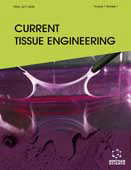Abstract
Because of the rising demand for replacing failure organs in transplantation therapy, tremendous efforts have been made to reconstruct entire organs using tissue engineering. However, most successes have been restricted in avascular or thin tissues. For thicker tissues, oxygen and nutrients are harder to diffuse into implants and sustain cellular viability. Therefore, numerous attempts have been made to induce vascularization in engineered tissues, which focus on cellcell and cell-scaffold interactions, respectively. This review focuses on current researches in the field of biomimetic scaffold promoting the cell-scaffold interactions. Bioactive molecules, such as angiogenic growth factors, extracellular matrix proteins or adhesive peptides derived from them, either released from or attached to various scaffolds to stimulate endothelial cells to form lumen and vascular sprouting in vitro. With or without pro-seeding, the scaffolds could induce neovascularization and microvascular network anastomosis with the host circulation in vivo in varying degrees. This strategy is a big step forward towards the promotion of angiogenesis in vascular-insufficient tissues. Based on the achieved developments, more effective strategies have been developed for attaining the functional vascularized constructs.
Keywords: Angiogenesis, bioactive molecules, growth factor, peptide, protein, scaffold
 34
34

